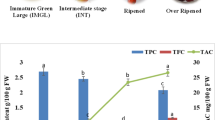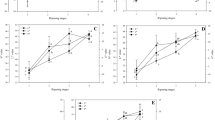Abstract
Ripening and growing location are important factors that can impact fruit quality characteristics. In this study, the influence of these factors on physicochemical characteristics, carbohydrates, aliphatic organic acids, phenolic compounds, and antioxidant capacity of red guava (Psidium cattleianum Sabine) was evaluated. Fruit ripening increased fructose and glucose (up to 22.83 and 16.42 g 100 g− 1 dry matter (DM), respectively), and decreased citric acid, the major organic acid (up to 135.35 mg g− 1 DM). Ripening and growing location also influenced the concentration of phenolic compounds and antioxidant capacity of red guava, in which a dependency between both factors was observed in most cases. Apigenin, galangin, isoquercitrin, among other phenolic compounds were quantified for the first time in red guava, in which isoquercitrin was the major (up to 13409.81 mg kg− 1 DM). The antioxidant potential of red guava was also confirmed by ferric reducing antioxidant power assay (up to 82.63 µmol Fe+ 2 g− 1 DM), Folin-Ciocalteu reducing capacity assay (up to 17.79 mg gallic acid equivalent g− 1 DM), and DPPH free radical scavenging assay (up to 25.36 mg ascorbic acid equivalent g− 1 DM). These results especially demonstrated the bioactive potential of red guava and provided knowledge regarding the influence of ripening and growing location on chemical and bioactive components encouraging its industrial exploitation.
Similar content being viewed by others
Data Availability
Data and material may be provided on request by the corresponding authors.
References
Yun Z, Gao H, Jiang Y (2022) Insights into metabolomics in quality attributes of postharvest fruit. Curr Opin Food Sci 45:100836
Perotti VE, Moreno AS, Podestá FE (2014) Physiological aspects of fruit ripening: the mitochondrial connection. Mitochondrion 17:1–6
Nehring P, Seraglio SKT, Schulz M et al (2022) Grumixama (Eugenia brasiliensis Lamarck) functional phytochemicals: effect of environmental conditions and ripening process. Food Res Int 157:111460
Pinto AA, Fuentealba-Sandoval V, López MD et al (2022) Accumulation of delphinidin derivatives and other bioactive compound in wild maqui under different environmental conditions and fruit ripening stages. Ind Crops Prod 184:115064
Lu X, Zhao C, Shi H et al (2023) Nutrients and bioactives in citrus fruits: different citrus varieties, fruit parts, and growth stages. Crit Rev Food Sci Nutr 63:2018–2041
Pereira ES, Vinholes J, Franzon RC et al (2018) Psidium cattleianum fruits: a review on its composition and bioactivity. Food Chem 258:95–103
Lopes MMA, Silva EO (2018) Araça — Psidium cattleyanum Sabine. In: Rodrigues S, Silva EO, Brito ES (eds) Exotic fruits, 1st edn. Academic Press, London, pp 31–36
Mallmann LP, Tischer B, Vizzotto M et al (2020) Comprehensive identification and quantification of unexploited phenolic compounds from red and yellow araçá (Psidium cattleianum Sabine) by LC-DAD-ESI-MS/MS. Food Res Int 131:108978
Rosário FM, Biduski B, Santos DF et al (2021) Red araçá pulp microencapsulation by hydrolyzed pinhão starch, and tara and arabic gums. J Sci Food Agric 101:2052–2062
Gomes GC, Gomes JCC, Cunha LF (2023) Produtividade do araçá-amarelo (Psidium cattleyanum L.) em sistema de produção ecológico aos seis anos da implantação. https://www.alice.cnptia.embrapa.br/bitstream/doc/868374/1/029.pdf. Accessed 27 Nov 2023
Dalla Nora C, Jablonski A, Rios AO et al (2014) The characterisation and profile of the bioactive compounds in red guava (Psidium Cattleyanum Sabine) and guabiju (Myrcianthes Pungens (O. Berg) D. Legrand). Int J Food Sci Technol 49:1842–1849
Medina AL, Haas LIR, Chaves FC et al (2011) Araçá (Psidium cattleianum Sabine) fruit extracts with antioxidant and antimicrobial activities and antiproliferative effect on human cancer cells. Food Chem 128:916–922
Pereira ES, Vinholes JR, Camargo TM et al (2021) Araçá (Psidium cattleianum Sabine): bioactive compounds, antioxidant activity and pancreatic lipase inhibition. Cienc Rural 51:20200778
Shi J, **ao Y, Jia C et al (2023) Physiological and biochemical changes during fruit maturation and ripening in highbush blueberry (Vaccinium corymbosum L). Food Chem 410:135299
García-Gómez BE, Salazar JA, Nicolás-Almansa M et al (2020) Molecular bases of fruit quality in Prunus species: an integrated genomic, transcriptomic, and metabolic review with a breeding perspective. Int J Mol Sci 22:333
Tian X, Zhu L, Yang N et al (2021) Proteomics and metabolomics reveal the regulatory pathways of ripening and quality in post-harvest kiwifruits. J Agric Food Chem 69:824–835
Cardoso PC, Sviech F, Reis MFA et al (2021) Development and application of a liquid chromatography-mass spectrometry method for the determination of sugars and organics acids in araza, ceriguela, guava, mango and pitanga. Braz J Food Technol 24:2020169
Søltoft-Jensen J, Hansen F (2005) 15 – new chemical and biochemical hurdles. In: Da-Wen S (ed) Emerging technologies for food processing, 1st edn. Academic Press, London, pp 387–416
Izawa K, Amino Y, Kohmura M et al (2010) 4.16 – human–environment interactions – taste. In: Hung-Wen L, Mander L (eds) Comprehensive natural products II, 1st edn. Elsevier, New York, pp 631–671
Li X, Li C, Sun J, Jackson A (2020) Dynamic changes of enzymes involved in sugar and organic acid level modification during blueberry fruit maturation. Food Chem 309:125617
Yang S, Meng Z, Li Y et al (2021) Evaluation of physiological characteristics, soluble sugars, organic acids and volatile compounds in ‘orin’ apples (Malus domestica) at different ripening stages. Molecules 26:807
Betta FD, Nehring P, Seraglio SKT et al (2018) Phenolic compounds determined by LC-MS/MS and in vitro antioxidant capacity of Brazilian fruits in two edible ripening stages. Plant Foods Hum Nutr 73:302–307
Pereira-Netto AB (2018) Tropical fruits as natural, exceptionally rich, sources of bioactive compounds. Int J Fruit Sci 18:231–242
Abbas M, Saeed F, Anjum FM et al (2017) Natural polyphenols: an overview. Int J Food Prop 20:1689–1699
Septembre-Malaterre A, Boumendjel A, Seteyen ALS et al (2022) Focus on the high therapeutic potentials of quercetin and its derivatives. Phytomed Plus 2:100220
Alsharairi NA (2023) Quercetin derivatives as potential therapeutic agents: an updated perspective on the treatment of nicotine-induced non-small cell lung cancer. Int J Mol Sci 24:15208
Sun W, Shahrajabian MH (2023) Therapeutic potential of phenolic compounds in medicinal plants—natural health products for human health. Molecules 28:1845
Günther CS, Plunkett BJ, Cooney JM et al (2022) Biotic stress-induced and ripening-related anthocyanin biosynthesis are regulated by alternate phytohormone signals in blueberries. Environ Exp Bot 203:105065
Shahab M, Roberto SR, Ahmed S et al (2020) Relationship between anthocyanins and skin color of table grapes treated with abscisic acid at different stages of berry ripening. Sci Hortic 259:108859
Chaves VC, Boff L, Vizzotto M et al (2018) Berries grown in Brazil: anthocyanin profiles and biological properties. J Sci Food Agric 98:4331–4338
Siebeneichler TJ, Crizel RL, Reisser PL et al (2022) Changes in the abscisic acid, phenylpropanoids and ascorbic acid metabolism during strawberry fruit growth and ripening. J Food Compos Anal 108:104398
Baldi P, Orsucci S, Moser M et al (2018) Gene expression and metabolite accumulation during strawberry (Fragaria × ananassa) fruit development and ripening. Planta 248:1143–1157
Schulz M, Seraglio SKT, Della Betta F et al (2020) Determination of phenolic compounds in three edible ripening stages of yellow guava (Psidium cattleianum Sabine) after acidic hydrolysis by LC-MS/MS. Plant Foods Hum Nutr 75:110–115
Luximon-Ramma A, Bahorun T, Crozier A (2003) Antioxidant actions and phenolic and vitamin C contents of common Mauritian exotic fruits. J Sci Food Agric 83:496–502
Funding
The authors would like to thank CAPES – Brazil (Finance code 001) and CNPq – Brazil (Grant numbers 165753/2020-0, 150915/2022-5, 150069/2021-9, and 309702/2022-4) for financial support.
Author information
Authors and Affiliations
Contributions
Conceptualization: SKTS and MS; Investigation: SKTS, MS, BS, CTPD; Writing – original draft: SKTS, MS, and BS; Writing – review and editing: SKTS, MS, BS, CTPD, RBH, LVG, RF, and ACOC; Supervising: RBH, LVG, RF, and ACOC.
Corresponding authors
Ethics declarations
Ethical Approval
Not applicable.
Conflict of Interest
The authors declare no conflict of interest.
Additional information
Publisher’s Note
Springer Nature remains neutral with regard to jurisdictional claims in published maps and institutional affiliations.
Electronic Supplementary Material
Below is the link to the electronic supplementary material.
Rights and permissions
Springer Nature or its licensor (e.g. a society or other partner) holds exclusive rights to this article under a publishing agreement with the author(s) or other rightsholder(s); author self-archiving of the accepted manuscript version of this article is solely governed by the terms of such publishing agreement and applicable law.
About this article
Cite this article
Seraglio, S.T., Schulz, M., Silva, B. et al. Chemical Constituents and Antioxidant Potential of Red Guava (Psidium cattleianum Sabine) from Southern Brazil in Different Edible Ripening Stages. Plant Foods Hum Nutr 79, 166–172 (2024). https://doi.org/10.1007/s11130-024-01141-6
Accepted:
Published:
Issue Date:
DOI: https://doi.org/10.1007/s11130-024-01141-6




